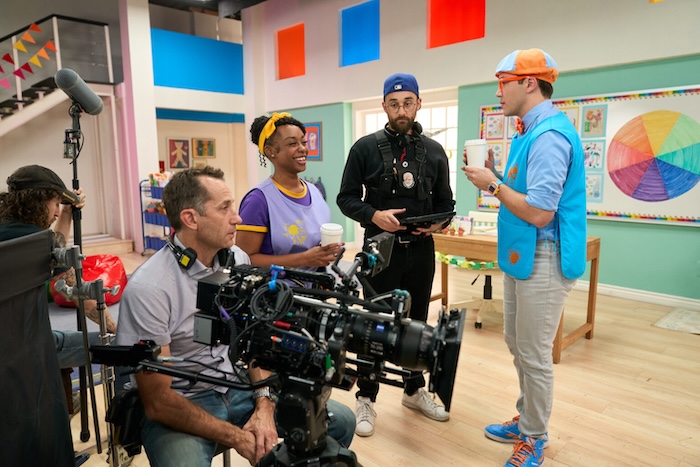
When Blippi’s Job Show hit Netflix, its visual style stood out: vibrant colors, animated energy, and a tactile sense of wonder tailored to its preschool audience. Behind the educational whimsy are cinematographers Nathan Wilson and Chris Collins, whose combined backgrounds in music videos, feature films, and documentary storytelling helped elevate the series beyond standard children’s fare.
Nathan Wilson didn’t set out to shoot children’s television. “I think the plan was to be a painter, or a guitar player” he surmises.” But after watching the film Seven and seeing Darius Khondji’s masterly approach to cinematography, he found a calling. “I realized there was somebody making decisions that were very painterly — and he was getting paid to do it.” To check it out more closely Wilson started his path as a PA and worked his way up through the camera department, from loader to DP.
For Wilson, shooting Blippi’s Job Show was a chance to bring his visual sensibility to a different audience. The show’s mission — introducing three-to-six-year-olds to a variety of jobs — called for both realism and imagination. “Each episode is a fun way for kids to learn about professions,” he explains. “A pizza chef, a pilot, a park ranger… we balance education with entertainment.”
Chris Collins, a longtime collaborator with director Shannon Flynn (Sesame Street, Helpsters), came to Blippi ‘s Job Show after working on Blippi’s Treehouse for Amazon. His approach to the Netflix iteration was guided by intimacy, authenticity — and personal connection. “I definitely did not get into cinematography to shoot kid shows,” he admits. It was personal. “I became a father right around the time. My oldest is now peak Blippi demo, so we’re able to watch it together.”
For Collins, the show’s success lies in its immersive, kid-level perspective. “Something kids loved about the original YouTube Blippi content was that there were very few cuts. It really felt like the the kid was the camera. That was the entire idea. Blippi was taking the kid around to explore different scenarios and meet new people. That was a major part of the success. It was really important that we represent things in as honest a perspective as possible. That meant natural lighting, true lenses, no vintage glass. We’re not trying to diffuse and beautify the image so much as to ring true.”
The show alternates directors and DPs, with Wilson and Collins leading their respective teams — but a shared visual language quickly emerged. “When Nathan came on board, he opened my eyes to possibilities I hadn’t seen before,” says Collins. “We wanted continuity of style so the camera operator would almost become its own character.”
Wilson brought his experience with LED volumes and musical content to bear, especially in shows where choreography and music took center stage. “We did a Blippi’s Job Show episode about a hip hop choreographer, and I got to dig deep into my music video roots — using interactive lighting, color, extreme wide angles.”
“It is a wide angle show”, points out Collins. “Not only is our lensing wide and bendy, the actual set design and set dressing is this inflated, animated world. So how do you blend almost an animated IP with real world and with lensing? While the original Blippi YouTube show followed Blippi around, in our show, we follow Blippi and his friend Meekah. There’s a lot of two shots, but we shoot on a wide lens so it feels like we’re very close to them.” Plus there’s the direct camera engagement that’s a bit unusual. Collins explains, “As Blippi and Meekah make direct engagement with the camera, we often drift together. This allows us to close focus on the wide lenses and really create shallow depth of field, behind them making the direct engagement more accentuated.”
The show’s visuals owe much to its carefully curated camera and lens package. On location, the DPs relied on Sony FX6s paired with Zeiss Nano primes. “When we had to shoot inside a tiny airplane fuselage — the FX3 and Nanos fit the bill. “Having a small compact package that’s handheld all day long and still having the beautiful attributes of larger lenses was a lifesaver,” says Wilson.
They were happy to deepen their knowledge of LED Volume and Unreal Engine while working a third of the time at Nant Studios. The choice there was pairing Sony Venice and Zeiss Supreme Primes.
For scenes requiring tighter coverage or dance inserts, Zeiss Compact Zooms were the solution. “We used the 70–200mm zoom a lot,” says Collins. “For dancing, you want to see head-to-toe but also get insert shots of toes and fingers. The Compact Zooms cut really nicely with the Nanos and Supremes.”
The choice of large format cinematography brought depth to the show’s wide-angle aesthetic. “The combination of using large format with the Zeiss lenses at a relatively shallow depth of field really helped separate our characters and draw attention to Blippi and Meekah,” notes Collins. “Having a T1.3 lens in your bag of tricks is something every cinematographer likes.”
Beyond the artistry and technology, both DPs agree: the energy on set was unlike anything they’d experienced. “We had an outrageous amount of fun,” Wilson says. “Great music, singing, dancing — it lifted the whole crew.” Collins echoes the sentiment. “On stage while Nathan was shooting, I walked by our key grip, who was on the walkie singing, ‘We did a really great job’.” And it just brightened my day.”
To see the interview visit: https://www.youtube.com/watch?v=GjDZ6_ngwlI&ab_channel=ZEISSCreativeAmericas
For more info on ZEISS visit: https://www.zeiss.com/consumer-products/us/cinematography.html















